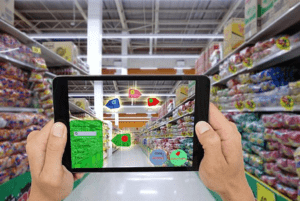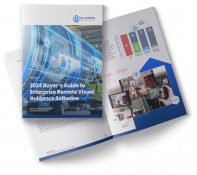
Have you ever been in this situation?
You’re shopping in a grocery store—one that’s in a remote location, not your day-to-day store—and you wander the aisles, looking for the specific brand of panko breadcrumbs you like. In fact, you can’t find any breadcrumbs, of any kind.
Finally, you give up and ask an employee (if you can find one), who shows you where they are—on a shelf you’re certain you walked past at least five times.
This scenario may soon become a distant, unpleasant memory, thanks to AR technology.
Advances in spatial computing—the technology that drives true three-dimensional interaction with an AR app—are poised to take AR to the next level, providing a fully immersive experience for the user through mobile devices, smart glasses, and even smart contact lenses.
Spatial augmented reality has immense implications for many areas of life, both personal and professional. Consider your supermarket shopping experience in the not-too-distant future:
- Before you leave the house, or perhaps on the way to the market, you consult with your smart pantry and refrigerator, along with your favorite virtual cookbook, to compile a shopping list.
- As you enter the doors of the market, you’re greeted by virtual markers indicating directions on the floor, guiding you to the location of each item on your list.
- Glancing down other aisles, you are presented with information about other items on special that you might be interested in, based on past purchases and recipe choices.
- As you pick each item from the shelf, your AR display shows you the item’s description, price, and nutrition information, along with nearby alternatives that might be a better value.
- As you place each item in your cart, you see a running total of the bill, to make sure you don’t overspend.
- Bypassing the checkout lines, you head straight out the door. Your AR supermarket app tells the market’s checkout system what you bought and automatically charges your favorite payment method.

Spatial augmented reality affords major advantages to the grocer as well. For instance, prices can self-adjust on the basis of market conditions. If everyone in town is running out to buy canned goods before a storm or chicken wings for the Super Bowl, for example, the price on those products could bump higher. Back at corporate headquarters, upper management can track and manage store conditions and inventory from the store manager’s device.
Spatial AR: Not Just For Consumers
The augmented shopping experience just described has parallels in many aspects of commercial life, not just in retail. Consider these possibilities:
- Training time is cut in half when employees can quickly, easily learn on-the-job every step in repair or maintenance processes via AR guided views.
- As a field service technician, you travel to a customer site for routine work on some of their machines. Your smart device not only tells you which machines need attention but also guides you to the location of each on the customer’s factory floor.
- As you approach each machine, your augmented vision device shows you a wealth of information about the device, both static (serial number, date placed in service) as well as dynamic (run hours, faults, critical operational parameters), updated in real-time from sensors installed on the machine.
- As you get to work on a machine, your device shows you step-by-step instructions and highlights, on your view of the machine, the components you need to touch in each step.
- If you need additional help, you can call on engineers and technicians at the home office, who can see what you’re seeing and walk you through the solution – adding annotated instructions to your visual display.
The advantages of spatial computing don’t stop there. AR will enhance on-the-job training and services for myriad professions in every industry, from groceries to factories to hospitals, at a far lower cost. Smart glasses are already beginning to guide manufacturing plant employees as they learn how to assemble new equipment. Retailers stand to significantly reduce the time it takes to train a new employee with AR tours and product descriptions.
Your Life Will Be Augmented
For grocery shoppers and field service technicians and everyone in between, spatial AR technology is poised to improve the experiences of all. For iOS devices alone, the number of AR apps available numbers in the thousands, and sales of headsets and other mini augmented vision devices are expected to more than double each year for the next few years.
AR is now hitting its stride. The time to take advantage of it—as a consumer, retailer, factory owner, or field-service technician—is now.
Connect with Help Lightning if you’d like a demonstration of Help Lightning, and to discuss how AR-enabled remote visual support can help your business optimize operations and increase revenue.












